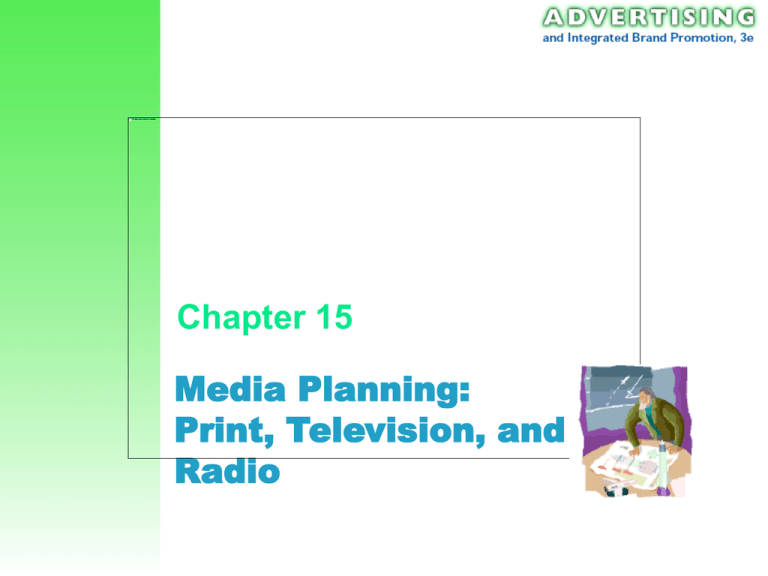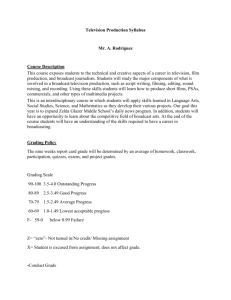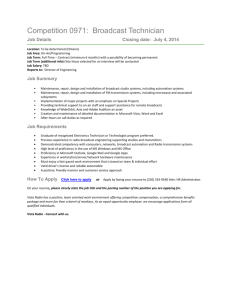Document
advertisement

Chapter 15 Media Planning: Print, Television, and Radio Which Media: Print, Television or Radio? 1. Great ads will fail if the media chosen do not reach the right audiences. 2. Newspapers and magazines have inherent advantages and disadvantages. 3. Broadcast media, TV and radio, also have inherent advantages and disadvantages. Chapter 14: Media Planning 2 Print Media • Newspapers – $50.4 billion spent on newspaper ads in 2001 – Ideal for reaching narrow geographic area – Facing circulation declines Chapter 15: Print, Broadcast 3 Newspaper Advantages • • • • • • • Reach over 50% of households Excellent medium for local markets Timeliness Creative opportunities Credibility Audience interest Cost Chapter 15: Print, Broadcast 4 Newspaper Disadvantages • • • • Limited segmentation Creative constraints Cluttered environment Short life Chapter 15: Print, Broadcast 5 Types of Newspapers • Target Audience – General Population – Business – Ethnic • Frequency of Publication – Daily – Weekly • Geographic coverage – Metropolitan area – State – National Chapter 15: Print, Broadcast 6 Categories of Newspaper Advertising • Display Advertising – Display advertising – Co-op advertising • Classified Advertising • Inserts – Preprinted insert – Free-standing insert Chapter 15: Print, Broadcast 7 Costs and Buying Procedures for Newspaper Ads • Rate Cards • Costs determined by: – – – – Size of ad Use of color Size of audience Extent of coverage • Space is sold in column inches or SAU sizes • Rates lower for ROP (run of paper) rather than preferred position or full position. Chapter 15: Print, Broadcast 8 Measuring Newspaper Audiences • Circulation – Paid circulation – Controlled circulation • Readership Chapter 15: Print, Broadcast 9 Future of Newspapers • Survival of newspapers depends on ability to evolve • In the future, newspapers will have to: – Provide in-depth coverage of local issues – Increase coverage of national and international events – Provide follow-up reports of news – Maintain role as local source for consumer information – Become more mainstream in integrated brand promotions relating to new media Chapter 15: Print, Broadcast Magazines • Over $3 billion spent for advertising space in magazines annually • Magazines show diversity as a media class Chapter 15: Print, Broadcast 11 Magazine Advantages and Disadvantages • Advantages – – – – Audience selectivity Audience interest Creative opportunities Long life • Disadvantages – – – – Limited reach and frequency Clutter Long lead times Cost Chapter 15: Print, Broadcast 12 Types of Magazines • Consumer publications – Men’s Journal, Women’s Day, Ebony • Business publications – American Family Physician, Forbes • Farm publications – Successful Farming, Progressive Farmer Chapter 15: Print, Broadcast 13 Costs and Buying Procedures for Magazines • Costs determined by: – – – – Circulation Size of ad Use of color Position in publication • Rates also vary for: – Bleed page – Gatefold ad – Run-of-paper advertisement – Preferred position Chapter 15: Print, Broadcast 14 Measuring Magazine Audiences • Rates are based on guaranteed circulation – Stated minimum number of copies that will be delivered to readers • Publishers also estimate pass-along readership • Estimates are verified by Audit Bureau of Circulations Chapter 15: Print, Broadcast 15 Future of Magazines • Last 15 years a roller coaster for magazines – Currently: revenues and ad pages are up – Advertisers find magazines useful • Continued success requires – Adapting to new media options – A robust environment for mergers and acquisitions in the industry Chapter 15: Print, Broadcast 16 Television • For many TV defines what advertising is • In 2001 advertisers spent $55 billion on television • Many more billions are spent on commercial production Chapter 15: Print, Broadcast 17 Television Categories • Network television • Cable television • Syndicated television – Off-network syndication – First-run syndication – Barter syndication • Local television • Satellite and closed-circuit television Chapter 15: Print, Broadcast 18 Advantages and Disadvantages of Television • Advantages – Creative opportunities – Coverage, reach, and repetition – Cost per contact – Audience selectivity Chapter 15: Print, Broadcast 19 Advantages and Disadvantages of Television • Disadvantages – Fleeting message – High absolute cost – Poor geographic selectivity – Poor audience attitude and attentiveness – Clutter Chapter 15: Print, Broadcast 20 Buying Procedures for Television Advertising • • • • Sponsorship Participation Spot advertising Choosing a daypart – – – – Morning Daytime Early fringe Prime-time access – Prime time – Late news – Late fringe Chapter 15: Print, Broadcast 21 Measuring Television Audiences • Source for network and local audience information: – A. C. Nielsen • Arbitron provides network information Chapter 15: Print, Broadcast 22 Measures of TV Audiences • Television households – Number of households in a market owning a television • Households using television (HUT) – Number of households tuned to a TV program in a time period Chapter 15: Print, Broadcast 23 Measures of TV Audiences • Program Rating – Percentage of TV households in a market that are tuned to a program during a time period Program rating = X Files rating = TV households tuned to a program Total TV households in the market 19,500,00 95,900,00 = 20 rating Chapter 15: Print, Broadcast 24 Measures of TV Audiences • Share of Audience – Proportion of households using television (HUT) in a specific time period that are tuned to a program Program Share = X Files share = TV households tuned to a program Total TV households using TV 19,500,00 65,000,000 = 30 share Chapter 15: Print, Broadcast 25 Future of Television • Future appears exciting • Interactive era will affect TV as an advertising medium – Viewer participation – Technology to transmit ads to a wide variety of new devices – TV advertising likely to be sent via broadband and wireless • Increase in direct broadcast by satellite • HDTV Chapter 15: Print, Broadcast 26 Radio • Radio categories – Radio networks – Radio syndication – AM versus FM • Types of radio ads – Local spot radio – Network radio advertising – National spot radio advertising Chapter 15: Print, Broadcast 27 Radio Advantages and Disadvantages • Radio advantages – Cost – Reach and frequency – Target audience selectivity – Flexibility and timeliness – Creative opportunities • Radio disadvantages – Poor audience attentiveness – Creative limitations – Fragmented audiences – Chaotic buying procedures Chapter 15: Print, Broadcast 28 Buying Procedures for Radio Advertising • Ad time may be purchased from networks, syndications, or local radio stations • About 80% is placed locally • Radio has five basic dayparts – – – – – Morning drive time Daytime Afternoon/evening drive time Nighttime Late night Chapter 15: Print, Broadcast 29 Measuring Radio Audiences • Average quarter hour persons – Average number of station listeners in a 15minute segment • Average quarter-hour share – Percentage of total radio audience listening to a station during a specified 15-minute segment • Average quarter-hour rating – Audience during a quarter-hour expressed as a percentage of the measurement area population • Cume – Total number of different people who listen for at least five minutes in a 15-minute segment Chapter 15: Print, Broadcast 30 The Future of Radio • Subscription radio • Emerging technologies and new media • Satellite radio Chapter 15: Print, Broadcast 31




